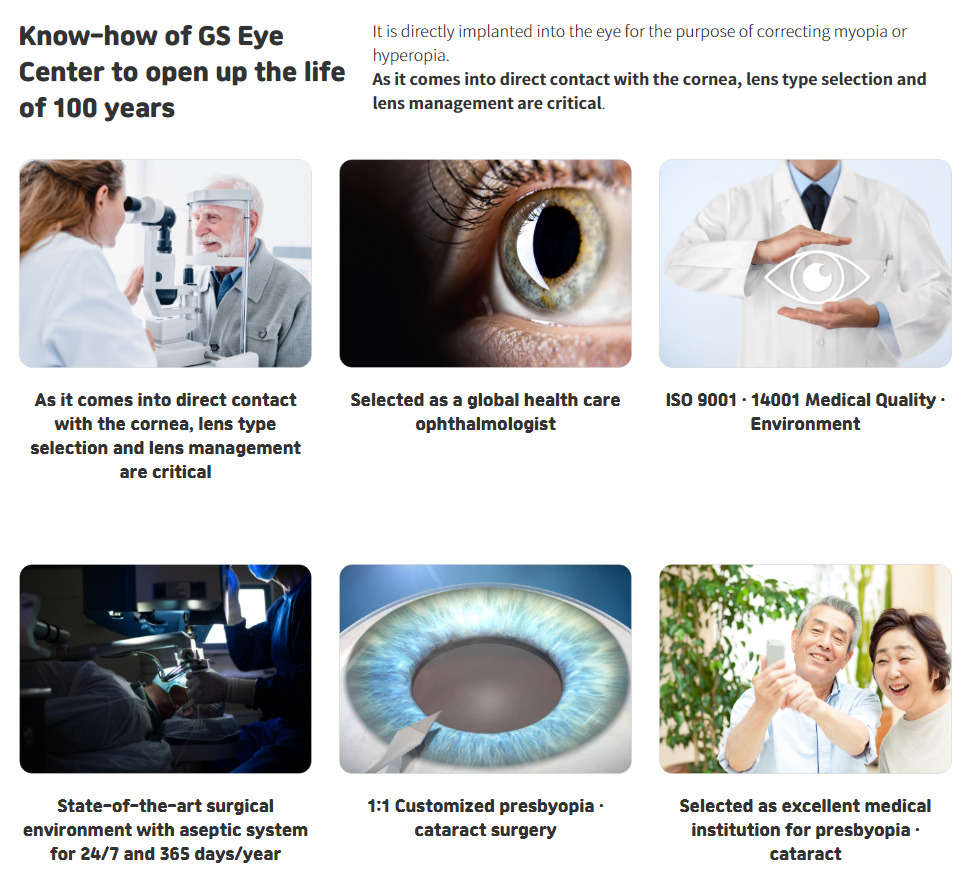Presbyopia and cataracts are two common, progressive eye conditions that lead to a deterioration in a person’s vision. Slow-developing and common in older adults, these conditions are frequently confused. After all, either presbyopia or cataracts can lead to hazy, blurred vision.

So, how do you know which condition you have? What are the cataracts and presbyopia symptoms? Is there a way to test at home? And how much is cataracts surgery and presbyopia surgery? We’ll answer all your questions below.
What is a Cataract?

A cataract is a clouding or opacification of the normally clear lens of the eyes. It occurs when proteins in the lens clump together, causing clouding in a part or the entire lens. As protein aggregations grow larger, it becomes harder and harder to see.
In a healthy eye, a clear lens allows light to pass through the eye, producing clear and sharp images on the retina. However, cataracts prevent this process, resulting in a gradual visual loss. In fact, cataracts are the leading cause of blindness worldwide.
Cataracts are most commonly due to aging but can also result from trauma, radiation exposure, certain medications, and conditions like diabetes.
There are several types of cataracts:
- Nuclear cataract: Forms in the center of the lens and is usually due to aging.
- Cortical cataract: Begins at the outer rim of the lens and moves centrally.
- Posterior subcapsular cataract: Starts at the back of the lens and tends to progress rapidly.
- Congenital cataracts: Some people are born with cataracts or develop them in childhood.
Cataracts Symptoms
Common cataracts symptoms include:
- Difficulty seeing in low light
- Blurry vision
- Halos around lights
- Heightened sensitivity to bright light
- Colors appear less vibrant
- Seeing double in the impacted eye
- Constant changes in eyeglass prescriptions
What is Presbyopia?

출처: Freepik
Presbyopia is an age-related condition in which your eye gradually loses the ability to focus quickly on objects that are close. It occurs when the lens becomes less flexible – especially in individuals in their mid-40s and onwards.
Usually, the lens changes its shape to focus on objects near or far. However, as the lens loses its flexibility, the muscles pulling on it cannot change its shape effectively. Tasks like reading or writing become more challenging as a result.
Presbyopia can occur alongside cataracts and other refractive or lens-related disorders. However, it should be considered distinct from vision disorders like myopia (nearsightedness), hyperopia (farsightedness), and astigmatism.
Presbyopia Symptoms
Common presbyopia symptoms include:
- Difficulty reading small print, especially in low-light conditions
- Needing to hold reading materials farther away to see them clearly
- Headaches or eye strain after tasks that involve close-up focus, like reading or sewing
- Needing reading glasses or bifocal lenses to see up close
- Tired eyes after engaging in close-up tasks for prolonged periods
- Blurred vision at a normal reading distance
- Frequently squinting when trying to read or do near work
Key Differences Between
Simple Presbyopia and Presbyopia
With Cataracts

Presbyopia: difficulty seeing things close to you and seeing things farther away

Cataracts: blurry vision both far and near
With presbyopia, the lens loses its elasticity, making it harder to see things clearly. Cataracts are a clouding of the lens, making things appear blurry and cloudy. People often confuse presbyopia with cataracts because presbyopia comes on gradually with age and makes things look blurry. We recommend regular examinations at GS Ophthalmology to know and deal with your current eye condition.
| Feature | Simple Presbyopia | Presbyopia with Cataracts |
|---|---|---|
| Definition | Age-related loss of the lens’s flexibility makes it difficult to focus on close objects. | Both age-related loss of lens flexibility (presbyopia) and clouding of the lens (cataract) are present. |
| Primary Cause | Age-related changes in the lens’s elasticity. | Age-related changes in the lens lead to both loss of elasticity and opacification. |
| Main Symptom | Difficulty in reading or seeing close objects clearly. | Difficulty in reading plus blurriness, reduced color intensity, and potential glare issues. |
| Vision Affected | Close-up vision primarily affected. | Both close-up and distance vision can be affected. |
| Treatment | Reading glasses, bifocals, progressive lenses, or specific contact lenses. | Treatment for presbyopia, as mentioned, plus potential cataracts surgery for lens replacement if the cataract progresses. |
| Appearance of Eye | Typically normal in appearance. | Cloudy or milky appearance if cataract is advanced. |
| Progression | Gradual loss of near-focusing ability over time. | Gradual worsening of both near focus and overall clarity due to the cataract. |
Presbyopia and Cataracts: Self-Testing

출처: Freepik
Experiencing difficulty reading fine print or needing to hold objects further away for clarity may signal presbyopia. Blurring vision, faded colors, and increased light sensitivity are common for cataracts.
A simple test involves reading in varied lighting. If vision remains blurred or you see halos around lights, consult an eye specialist. Always seek professional advice for a definitive diagnosis.
Early Detection and Management of Presbyopia and Cataracts
Cataracts, in particular, benefit significantly from an early diagnosis. Because it is a progression condition, the cataract will continue to worsen with cataract treatment. That usually involves a surgical procedure.
In contrast, presbyopia isn’t usually a major problem until it’s significantly advanced. Adults with no symptoms or risk factors should undergo a baseline examination at age 40. Subsequent routine examinations can detect the early signs of disease and vision changes. It also helps identify cataracts.
Presbyopia and Cataracts Treatment

Presbyopia Treatment
For presbyopia, treatment typically involves some form of corrective glasses, including reading glasses, bifocals, or progressive lenses. Contact lenses designed explicitly for presbyopia, like multifocal contacts, are also available.
Surgery is also possible. Options include:
- Conductive keratoplasty (CK) uses radiofrequency to adjust the cornea’s curvature; effects may fade for some.
- Laser-assisted in-situ keratomileusis (LASIK) creates monovision: one eye for nearness, the other for distance.
- Refractive lens exchange substitutes the natural lens with an intraocular implant.
Cataracts Treatment
Cataract treatment, in contrast, usually involves a surgical procedure to remove the clouded lens and replace it with a clear artificial lens. Advanced technology lenses, like multifocal or accommodative IOLs, can also address presbyopia during cataracts surgery – reducing the reliance on glasses or other non-surgical solutions.
?3 Things about cataracts surgery that you are curious about! – Watch now
Cataracts Surgery Cost: How Much?

출처: Freepik
Cataracts surgery costs can vary widely based on factors such as location, surgeon’s expertise, facility fees, and the type of intraocular lens chosen. National health insurance systems or private insurance plans might cover a significant portion when the surgery is deemed medically necessary. However, consulting with healthcare providers or clinics for specific financial details and coverage options is recommended.
GS Eye Clinic – Treat Your Cataracts and Presbyopia Symptoms

GS Ophthalmology specializes in treating presbyopia and other eye problems. We provide diagnosis, guidance, and treatment scheduling. Located at Exit 1 of Gangnam Station, GS Ophthalmology has been selected as an Excellent Medical Center for Presbyopia and a Global Health Care Ophthalmology Target, and provides 1:1 personalized presbyopia cataract surgery

Cataract FAQs
- What happens if I don’t have cataract surgery?
If left untreated, cataracts can cause an increase in intraocular pressure, which can lead to secondary glaucoma. As cataracts worsen, the surgical process becomes more difficult and the chances of complications during surgery increase, so it is recommended to have surgery at an early stage.
- Do you operate on both eyes at the same time?
We safely operate on one eye per day, 1-2 days apart.
- Do I need reading glasses after surgery?
There are two types of cataract surgery: multifocal IOLs, which correct presbyopia and cataracts at the same time, do not require reading glasses. Monofocal IOLs, which replace only the clouded lens, do require reading glasses.

GS Eye Clinic specializes in presbyopia treatments and eye-related issues. We diagnose, guide, and schedule your treatment. Our 15-bed inpatient unit ensures proper recovery time. Our team, consisting of four lead practitioners at GS Ophthalmology, delivers top-tier presbyopia treatments.



Explore more about us on our YouTube Channel or Instagram, where we address queries like treatment duration, post-treatment care, how much cataracts surgery costs, and activities to avoid. If you’re experiencing cataracts or presbyopia symptoms, reach out to GS Eye Clinic for a consultation.
? Everything you need to know about cataracts surgery
What is Cataracts and how to treat Cataracts?
The Cataracts occurs when the natural lens at the back of the iris and pupil becomes cloudy. The most effective way to treat cataracts is to under go cataract surgery to restore vision by removing and replacing the cataract-affected lens with an artificial one.
Where should I get my eye surgery in Korea?
GS Eye Clinic in Seoul, Korea, is at the forefront of the latest technological advancements in laser eye surgery, including cataract surgery, Smile Lasik, and Lasek. Please schedule a consultation with GS Eye Clinic today to explore your options via our KakaoTalk Channel or visit us at 8,15,16F, Mizin Plaza, 390 Gangnam-daero, Gangnam-gu, Seoul, Korea.
How much does eye surgery in Korea cost?
According to the Medical Tourism site's chart, Korea ranked second as the best destination for laser eye surgery because of its advanced technology and affordable price. The total cost for both eye surgeries in Korea is lower than that in other countries. Don't hesitate to contact GS Eye Clinic via our KakaoTalk Channel for more information about the total price of eye surgery in Korea.
GS Ophthalmology Center
Directions 8,15,16F, Mizin Plaza, 390 Gangnam-daero, Gangnam-gu, Seoul, Korea





